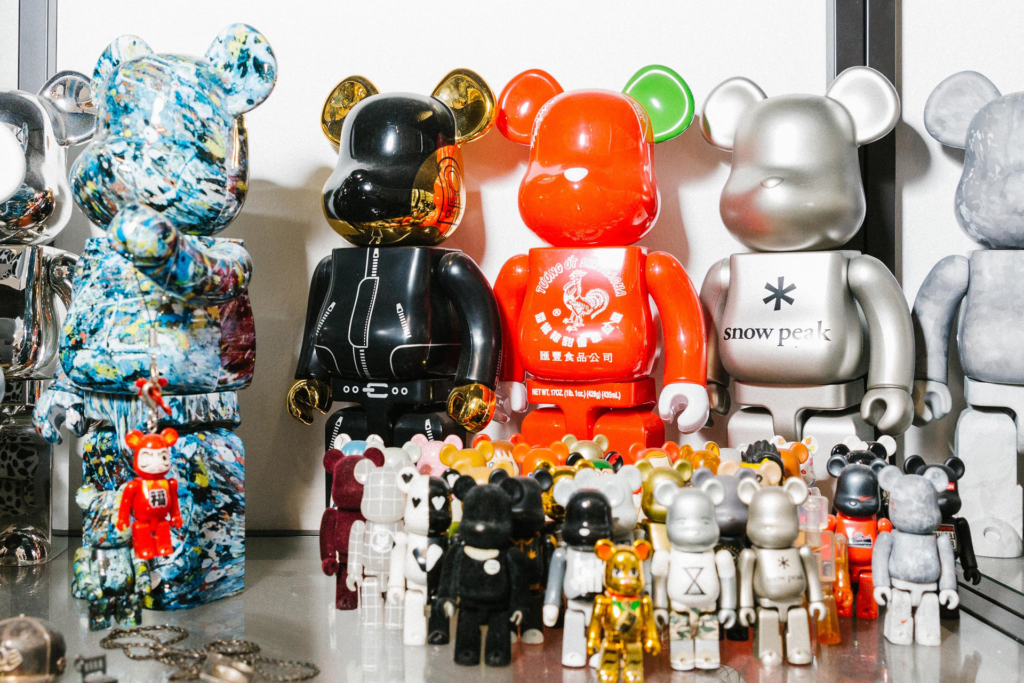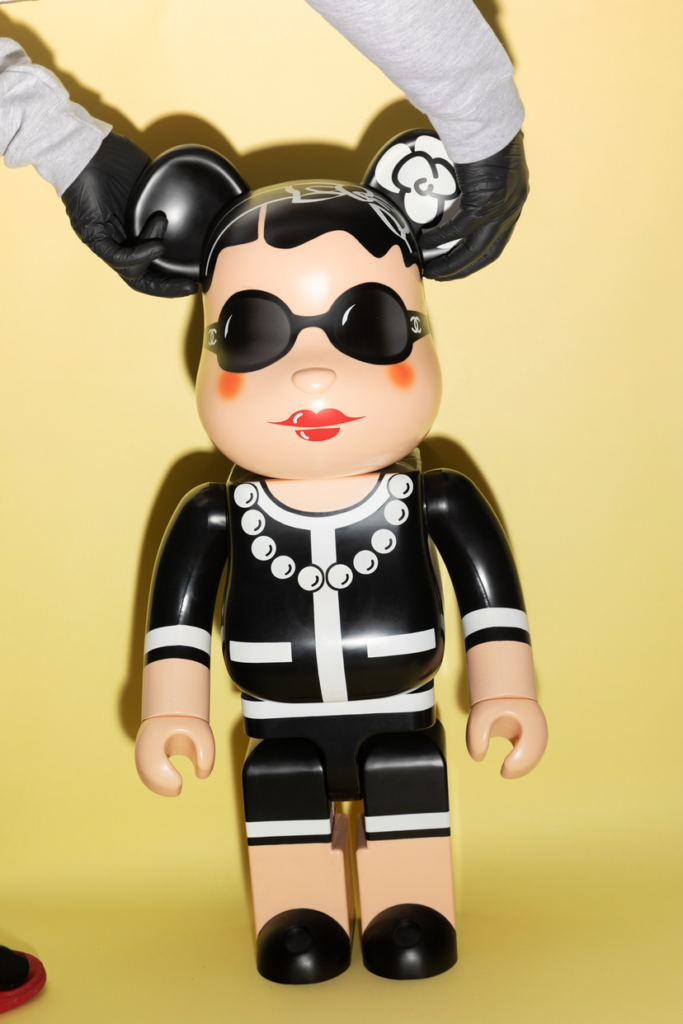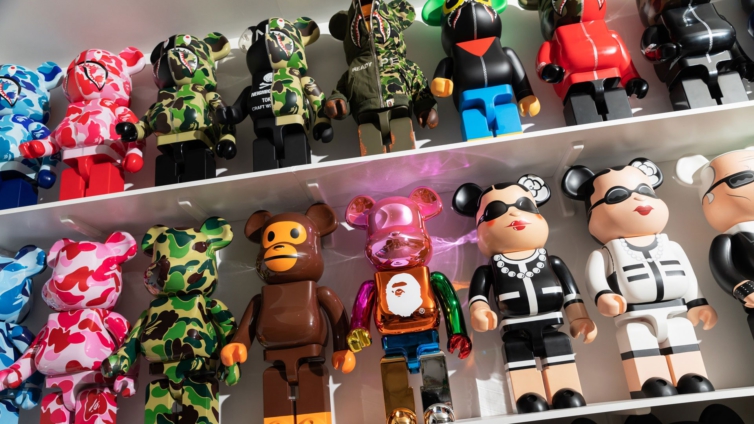Every few weeks in the mid-aughts, a “crazy, crazy” car—a 2006 Bentley Flying Spur, to be precise—would pull up to Mobius, Wonhee Lee’s half-gallery half-streetwear store in Los Angeles. Lee knew the driver well, not just because he was the famed celebrity jeweler Ben Yang, better known as Ben Baller, but because the two had developed a predictable routine.
A half-dozen roughly two-foot-high boxes would come in the mail. Lee would give his loyal customer a call, and Yang would speed over in his Bentley. In the boxes? Bearbricks (formally Be@rbrick), the massive Japanese toy company Medicom signature item, and one that’s had its paw fully in the honeypots of streetwear, art, and design over the past 18 years.
Lee’s Mobius was one of only a couple of stores importing Bearbricks to Los Angeles, so Yang would purchase as many as he could. Then, he would gingerly strap his prizes into children’s car seats.
“These are his babies,” Lee says, by way of context. Then Ben Yang would drive off with all the merriment of a car clacking with Just-Married cans.

Today, Yang is likely the best-known Bearbrick collector on the planet. Eddie Cruz, the former owner of Union Los Angeles and another early importer of the toys, first introduced Yang to the Kaws 1000% Bearbrick in 2002, and it was love at first sight. (The figures range in size from keychain-sized 50% toys to the toddler-height 1000%.) “Yo,” Yang recalls saying at the time, “I gotta have this thing.”
“I just collected them,” Yang says now. “I don't know what possessed me. I just thought they were cool.” The Kaws Bearbrick was his first, but soon Yang was in the vice grip of an obsession.
“I was like, ‘I'm not going to have five or six, bro. I need to have fucking 50 of them motherfuckers in the house.’ It makes no sense to do anything else.”
Yang eventually accumulated so many Bearbricks—ones designed by famous artists like Kaws or made in collaboration with labels like Chanel and Fendi—that he had to convert a wall into a display area for his toys. But Yang wasn’t the only one after the toys.
Mobius’s tiny allotment of Bearbricks was coveted by people like the comedian Bobby Lee and members of “Fly Like a G6” performers The Far East Movement. When Joe Hahn wasn’t working his job as the DJ for Linkin Park, he was running the art and apparel store Suru, and says that the Bearbricks he imported attracted customers like Jonah Hill and Seth Rogen, whose collection of the toys is on display in the opening scenes of This Is the End. (Hill and Rogen declined to comment.)

Despite the competition, Yang managed to amass a collection of stupefying value. In early 2012, in anticipation of the birth of his son, he moved to sell a collection of 40 Bearbricks and displayed them at the Guy Hepner gallery, a venue typically reserved for blue-chip art, in Los Angeles. The collection sold for “about a hundred grand,” Yang says. But it took an emotional toll: “I sold all the Kaws 1000%, and I'm like sick about it,” Yang says. “Like, that makes me want to fucking vomit.”
The success of the Bearbrick might be the most bizarre phenomenon in streetwear’s uniquely bizarre history. This is a fickle world that constantly trades out hot brands and trends like goldfish—and its longest-running, most surefire hit is... a plastic bear? Somehow, it is now de rigueur for brands new and established to create their own Bearbricks design and streetwear mainstays like Bape, Stussy, Fragment Design, and Staple flock to the toy. If you’re left scratching your head, you’re not alone.
“I don't want to name drop,” Jeff Staple, founder of the streetwear brand Staple Pigeon, says slyly, “but I was having lunch with James Jebbia of Supreme and he was like, ‘Oh, what's new?’” So Staple started to tell Jebbia, only the founder of the most successful streetwear brand in history, about an exciting new project he was working on.
“We have this Bearbrick coming out—” Staple started.
“‘Man,’” Jebbia jumped in, according to Staple, “‘those things are just fucking bullshit to me.’ He's like, ‘Me, Supreme, we'll never do a Bearbrick... Those things that just sit on your desk? It doesn't do anything. It's not heavy enough to be a paperweight, it's not luxurious—it's cheap plastic.’” Staple assures me Jebbia said this with good British humour.
Jebbia’s protestation makes sense. The Bearbrick represents everything most embarrassing about streetwear: it wholly embraces the genre’s childlike obsession with collecting and sometimes thoughtless branding. It’s literally a toy. Among non-collectors, Jebbia’s refrain is common: what the hell are these things? And crucially, why in the world are they so valuable?
And yet the Bearbrick has been remade by brands like Chanel, Hermès, Comme Des Garçons, Bape, Undercover, Sacai, and Fragment as well as artists like Kaws, Futura, and Hebru Brantley. It’s not heavy enough to be a paperweight, but people display them in their house with the pride reserved for Oscar statues. They’re not luxurious but people pay tens of thousands of dollars for sought-after editions.
The success of the Bearbrick, it turns out, is a deliriously happy accident—and one that explains better than anything else the random, hype-driven, and slapstick world of streetwear.

Latest Stories
-
Otto Addo was forced to accept Black Stars coaching job – Mohammed Polo
4 mins -
Karim Zito qualified to be Black Stars head coach – Mohammed Polo
11 mins -
Platinum Cup makes return on April 27
17 mins -
MoE is not changing uniforms or re-painting all public schools – Kwasi Kwarteng clarifies
50 mins -
16th Africa Aquatics Swimming Championships: Nubia and Harry to represent Ghana in Angola
57 mins -
Four defendants in NDA case by OSP open defence today
58 mins -
GFA commissions first set of floodlights at Ghanaman Soccer Centre of Excellence
1 hour -
Basic public school uniform change an initiative, not a policy – Kwasi Kwarteng
1 hour -
Bawumia appeals for peace in Gonjaland, donates GHȼ100K, bull
1 hour -
Drake: AI Tupac track gone from rapper’s Instagram after legal row
1 hour -
Repainting schools, changing uniforms a misplaced priority – Joy FM listeners on rebranding of basic public schools
1 hour -
UEFA U-16 Tournament: Black Starlets bounce back with 5-1 win over Serbia
2 hours -
There’s nothing strange about changing colours for basic public schools – Education Ministry PRO
2 hours -
Diana Asamoah causes arrest of personal assistant over GH₵4k MoMo theft
2 hours -
Adina impresses fans with new single ‘Emergency’
2 hours

